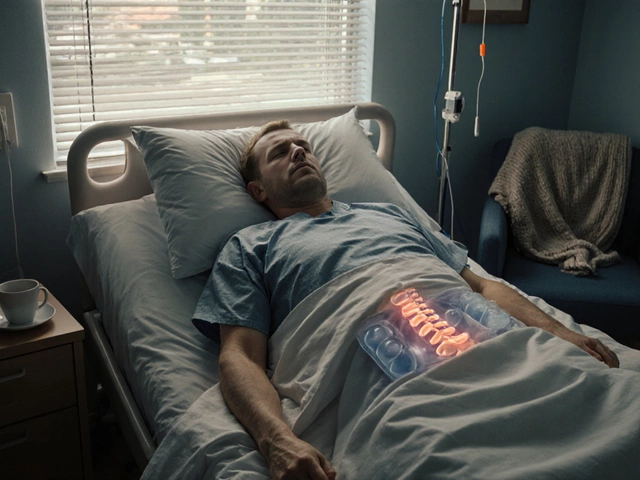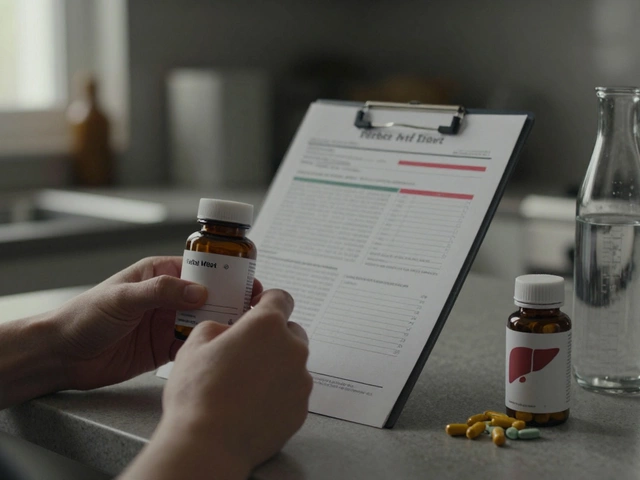- Home
- Orthopedics
- What Is the Most Painful Surgery to Get? Real Experiences from Orthopedic Patients

What Is the Most Painful Surgery to Get? Real Experiences from Orthopedic Patients
Spinal Fusion Pain & Recovery Estimator
How pain and recovery time can vary for you
This tool estimates your potential pain level and recovery timeline based on your specific medical factors. Remember, pain is subjective but these estimates are based on clinical studies and patient reports.
Your Estimated Pain Level
0
Recovery Timeline
Personalized Recommendations
When people ask what the most painful surgery to get is, they’re not just curious-they’re scared. Maybe they’ve been told they need an operation, or someone they love is facing one. The truth isn’t found in headlines or viral videos. It’s in the quiet moments after the anesthesia wears off, when the body screams what the mind can’t ignore.
Spinal Fusion Tops the List
Among all surgical procedures, spinal fusion consistently ranks as the most painful. It’s not because it’s the longest or most complex-it’s because it cuts through layers of muscle, ligaments, and nerves that were never meant to be disturbed. Surgeons remove damaged discs, grind down bone, and then fuse vertebrae together using metal rods and screws. The body reacts by inflaming every nearby nerve.
Patients describe it as a deep, constant ache that doesn’t go away with painkillers. Some say it feels like their spine is being pulled apart from the inside. One study published in the Journal of Neurosurgery: Spine in 2023 tracked over 1,200 spinal fusion patients. Nearly 68% reported moderate to severe pain for at least six weeks post-op. That’s longer than most people expect.
Why does it hurt so much? Unlike a knee replacement, where the joint is replaced and movement returns quickly, spinal fusion locks your spine in place. Your body fights that. Muscles stiffen. Nerves misfire. Even simple actions like sitting up or coughing trigger waves of pain. Recovery isn’t just about healing bone-it’s about retraining your nervous system.
Why Other Surgeries Don’t Quite Compare
People often think amputations or open-heart surgeries are worse. But those procedures, while life-altering, don’t usually cause the same prolonged, localized agony. Amputations involve nerve damage, yes-but the pain tends to shift into phantom limb syndrome, which is different from the raw, daily ache of spinal fusion.
Open-heart surgery hurts, too. The sternum is split open, and that’s brutal. But most patients report sharp pain that fades within days. The real struggle there is breathing, not constant burning. By contrast, spinal fusion pain doesn’t peak-it lingers. It creeps into sleep, work, and relationships.
Knee replacements? They hurt at first, but mobility returns fast. Within two weeks, many patients walk without crutches. Hip replacements? Same story. The pain is intense but short-lived. Spinal fusion? Six months is the minimum for real improvement. And even then, some never fully get back to how they felt before.
What Makes the Pain Worse?
Pain isn’t just about the surgery-it’s about what happens after. Smoking, obesity, and pre-existing nerve damage make spinal fusion pain worse. A 2024 study from the Mayo Clinic found that smokers had 3.2 times higher risk of chronic pain after fusion than non-smokers. Obesity added another layer: excess weight pulls on the fused area, keeping muscles tight and nerves irritated.
Also, mental health plays a role. Patients with anxiety or depression before surgery report pain levels 40% higher than those without. It’s not in their head-it’s biology. Stress hormones amplify pain signals. That’s why some hospitals now require psychological screening before approving fusion surgery.
And then there’s the isolation. Most surgeries let you move around, get visitors, go to the bathroom on your own. Spinal fusion? You’re stuck. No bending. No twisting. No lifting anything heavier than a coffee cup. For weeks. That helplessness makes the pain feel bigger.

Real Stories, Not Just Numbers
One patient, Maria, 52, had a two-level lumbar fusion after years of degenerative disc disease. She didn’t cry during surgery. She cried three weeks later, alone in her kitchen, trying to pick up a spoon. "I thought I’d be back to normal by then," she said. "I didn’t know pain could make you feel like you’ve lost part of yourself."
Another, James, 47, had a fusion after a car accident. He returned to work as a mechanic after three months-but couldn’t lift a wrench without pain. He still takes gabapentin daily. "I’m grateful to walk," he says. "But I’m not the same."
These aren’t rare cases. They’re the norm. And they’re why doctors now talk about "pain expectations" before surgery-not just success rates.
What Helps? Real Recovery Tools
There’s no magic cure. But some things make a measurable difference.
- Physical therapy before surgery (prehab) cuts post-op pain by up to 30%. Strengthening your core and back muscles helps your body handle the trauma.
- Ice packs and nerve blocks in the first 72 hours reduce inflammation that leads to long-term pain.
- Non-opioid pain management works better than you think. Medications like pregabalin and duloxetine target nerve pain directly. Many patients avoid opioids entirely.
- Gradual movement is key. Walking 10 minutes a day, even if it hurts, prevents muscle atrophy and nerve stiffness.
- Support groups-online or in-person-help patients feel less alone. One study showed participants reported 25% lower pain scores after joining a recovery community.
Some surgeons now use robotic-assisted fusion. It’s more precise, cuts less muscle, and leads to less pain. But it’s not widely available-and even then, pain doesn’t vanish.

Is It Worth It?
For many, yes. If you’re in constant pain, can’t sleep, or can’t play with your kids, spinal fusion can give you your life back. But it’s not a quick fix. It’s a trade-off: trade months of agony for years of relief.
Don’t rush into it. Get a second opinion. Ask your surgeon: "What’s the chance I’ll still have pain after six months?" If they dodge the question, walk away.
And if you’re already facing it? Know this: the pain will change. It won’t disappear overnight, but it will soften. The first week is the worst. The third month is the hardest. But by six months, most people say they’d do it again.
What About Other Surgeries?
Spinal fusion is the most painful-but it’s not the only one that hurts badly.
- Complex pelvic reconstruction after trauma or cancer removal: severe nerve pain, long recovery, high risk of chronic discomfort.
- Open abdominal surgery for bowel resection: deep internal pain, slow healing, risk of adhesions that cause ongoing discomfort.
- Amputation with nerve grafting: phantom pain and neuroma formation can last years.
But none of these match spinal fusion in how consistently, deeply, and for how long it hurts. It’s the one surgery where patients say, "I didn’t know pain could feel like this."
Final Thoughts
There’s no single "most painful" surgery for everyone. Pain is personal. But when you look at the data, the stories, and the science, spinal fusion stands out-not because it’s the most dangerous, but because it’s the most relentless.
If you’re considering it, prepare mentally as much as physically. Talk to people who’ve been through it. Don’t let fear stop you-but don’t let hope blind you either. This isn’t about being brave. It’s about being informed.
And if you’re already recovering? You’re not broken. You’re healing. And that takes time-more than anyone tells you.
Is spinal fusion the most painful surgery for everyone?
No, pain is subjective. Some people tolerate it better than others. But based on large-scale patient surveys and clinical data, spinal fusion causes the most consistent, prolonged, and severe pain compared to other major surgeries. It’s the most common answer from patients who’ve had multiple procedures.
How long does the pain last after spinal fusion?
Sharp pain usually fades in 4-6 weeks. But the deep, aching pain-what patients call "the background pain"-can last 3 to 6 months. For 15-20% of patients, some level of discomfort continues beyond a year, especially if there’s nerve damage or scar tissue buildup.
Can you avoid spinal fusion and still relieve pain?
Sometimes. Physical therapy, epidural steroid injections, nerve ablation, and spinal cord stimulators can help. But if you have severe disc degeneration, instability, or nerve compression, these won’t fix the root problem. Spinal fusion is often the last option that actually stops the pain long-term.
Why do some people still hurt after a successful fusion?
Fusion stops motion at one level, but that puts extra stress on the discs above and below. This can lead to adjacent segment disease. Also, nerves that were damaged before surgery may never fully recover. Scar tissue can also press on nerves. Success doesn’t mean zero pain-it means the main cause is gone.
Are there new techniques that reduce pain?
Yes. Minimally invasive spinal fusion (MIS) uses smaller incisions and avoids cutting muscles. Robotic guidance improves accuracy. Some surgeons now use biologics like bone marrow injections to speed healing. These don’t eliminate pain, but they reduce its intensity and shorten recovery time by weeks.

Arnav Singh
I am a health expert with a focus on medicine-related topics in India. My work involves researching and writing articles that aim to inform and educate readers about health and wellness practices. I enjoy exploring the intersections of traditional and modern medicine and how they impact healthcare in the Indian context. Writing for various health magazines and platforms allows me to share my insights with a wider audience.
About
Medical Resource Center India is a comprehensive online platform dedicated to providing reliable health information and medical resources in India. Explore a wide range of articles, tips, and advice on medicine, healthcare services, and wellness. Stay informed about the latest developments in Indian medicine and access valuable insights into maintaining a healthy lifestyle. Discover expert guidance and health solutions tailored for every Indian citizen. Your go-to destination for authoritative medical knowledge in India.






